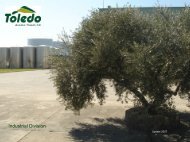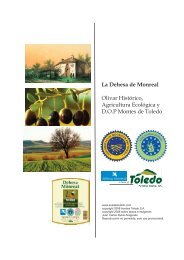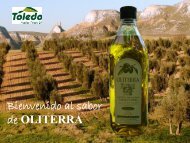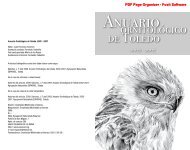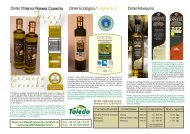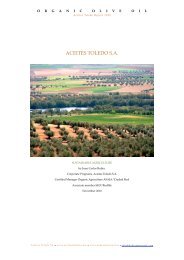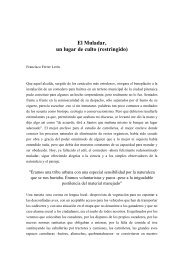On Olive Oil History and Facts. - Aceites Toledo SA
On Olive Oil History and Facts. - Aceites Toledo SA
On Olive Oil History and Facts. - Aceites Toledo SA
You also want an ePaper? Increase the reach of your titles
YUMPU automatically turns print PDFs into web optimized ePapers that Google loves.
<strong>Olive</strong> <strong>Oil</strong> <strong>History</strong> <strong>and</strong> <strong>Facts</strong><br />
Page 13<br />
The separated oil <strong>and</strong> vegetation water are then rerun through a vertical centrifuge, working<br />
around 6000 rpm that will separate the small quantity of vegetation water still contained in oil<br />
<strong>and</strong> vice versa.<br />
Three, Two, <strong>and</strong> Two <strong>and</strong> a half phases decanters<br />
A portion of the oil polyphenols is washed out due to the higher quantity of added water (when<br />
compared to the traditional method), producing a larger quantity of vegetation water that needs<br />
to be processed.<br />
The two phases oil decanter was created as an attempt to solve these problems. Sacrificing<br />
part of its extraction capability, it uses less added water thus reducing the phenol washing. The<br />
olive paste is separated into two phases: oil <strong>and</strong> wet pomace. This type of decanter, instead of<br />
having three exits (oil, water <strong>and</strong> solids), has only two. The water is expelled by the decanter<br />
coil together with the pomace, resulting in a wetter pomace that is much harder to process<br />
industrially. Many pomace oil extraction facilities refuse to work with these materials because<br />
the energy costs of drying the pomace for the hexane oil extraction often make the extraction<br />
process sub-economical. In practice, then, the two phases decanter solves the phenol washing<br />
problem but increases the residue management problem.<br />
The two <strong>and</strong> a half oil decanter is a compromise between the two previous types of decanters.<br />
It separates the olive paste into the st<strong>and</strong>ard three phases, but has a smaller need for added<br />
water <strong>and</strong> also a smaller vegetation water output. Therefore the water content of the obtained<br />
pomace comes very close to that of the st<strong>and</strong>ard three phases decanter, <strong>and</strong> the vegetation<br />
water output is relatively small, minimizing the residue management issues.<br />
Advantages <strong>and</strong> Disadvantages<br />
Advantages<br />
Compact machinery - one decanter can take the place of several presses<br />
Continuous <strong>and</strong> automated<br />
Limited labor required<br />
highest percent of oil extraction<br />
Vegetable water disposal less of a problem<br />
<strong>Olive</strong> oil from two-phase centrifugation systems contains more phenols, tocopherols, trans-2-<br />
hexenal <strong>and</strong> total aroma compounds <strong>and</strong> is more resistant to oxidation than oil from threephase<br />
ones <strong>and</strong> from hydraulic presses<br />
Disadvantages<br />
Expensive<br />
More technical labor required<br />
High energy consumption<br />
Pomace may end up moist<br />
Greater amount of vegetable water to be disposed of<br />
Reduced antioxidants due to added water<br />
Subject to wear from rocks, grit



